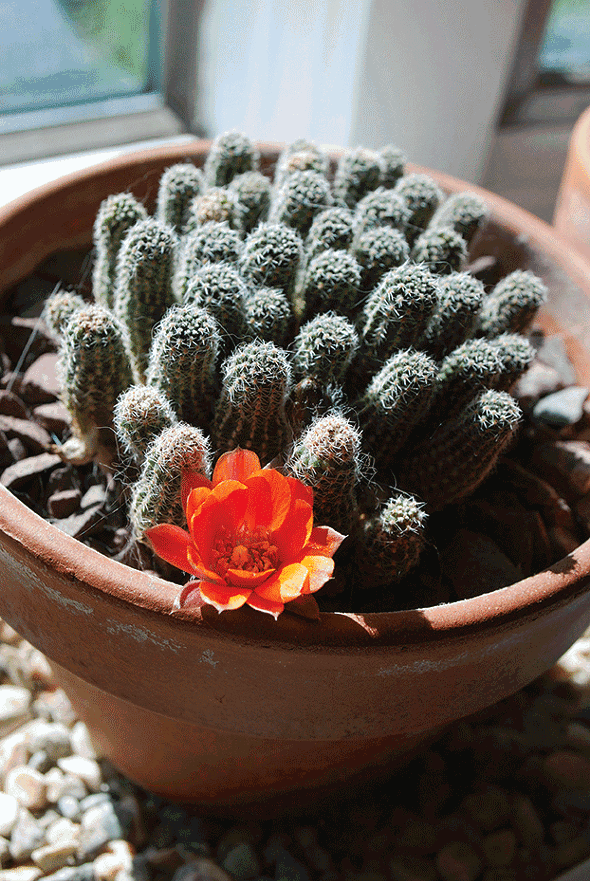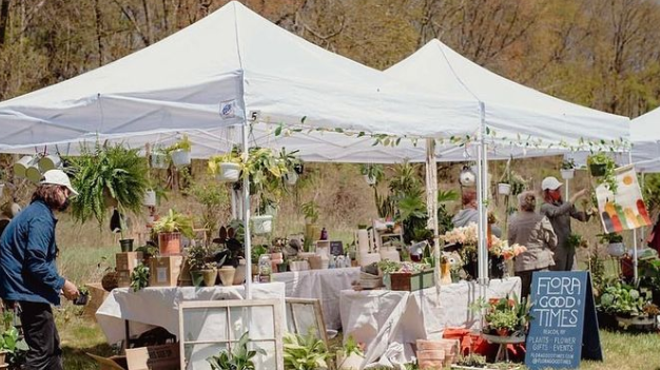The Water Storers
There are about 2000 species of cacti growing worldwide, in surprisingly diverse environments. The vast majority grow in semi-arid habitats, but some species grow in arid extremes, in grasslands, on mountain tops, on beaches, and in rainforests. For plant collectors and avid gardeners, cacti are the third most popular group of plants to collect, after orchids and roses.
What distinguishes a cactus from a succulent? Botanists regard cacti as a kind of succulent—that is, a plant that has thickened leaves, stems, or roots swollen with stored water. Horticulturists, however, generally don't use the term "succulent" in reference to cacti. They just say "cacti."
There are dozens of plant families that contain succulents, but cacti come from only one plant family, the Cactaceae. A cactus is deemed a cactus by virtue of its floral morphology (form/expression). When you see a plant and assume it's a cactus because of its fleshiness and spines, it may be a different kind of succulent. You would need to see the flowers to know.
Prickly Beginnings
Garden photographer Larry Decker has been growing cacti for nearly 50 years. In his high school in Northport, Long Island, students could pursue an independent learning program. Decker requested a plant room with grow lights in which he could grow whatever he wanted. They gave that to him with the stipulation that he take care of the school's indoor cactus plants. His mentor for this was a woman they called the "cactus lady," a noted regional author on the subject.
Decker says, "Mrs. Cangelosi shared with me everything she knew about cacti. She made me learn the Latin names. I fell in love with them." One of his cacti that now summers on his porch in Port Ewen was a gift from his mother in 1980.
Some general advice about buying cactus for use as indoor plants: Decker says, "Avoid the gimmicky kind with the brightly colored second cactus grafted on top; those seldom do well. Don't buy it for the flower; a lot of times they stick fake flowers on with pins! Find a good nursery where the cacti are not just being sold like floral arrangements to be disposed of. Look for cacti that are dark green and that don't have puckered spots, as puckering is an indication of drought stress."
Decker's Dos and Don'ts
Siting Your Indoor Cactus
"There's a popular misconception that all outdoor and indoor cacti should be in constant full sun," Decker says. "Many will burn that way. "Also, it's not true that cacti want to be hot all the time; too much heat can dry them out or kill them. Don't put them in a hot place with poor air circulation, and don't put them near the radiator." Decker grows some of his collection under grow lights, where they can get the light they need without the heat that comes with full sun window exposure. The overhead grow lights also promote straight stems.
If you think about the conditions of semi-arid or arid deserts, the day and night temps can differ substantially; the plants are used to having cool nights. How can you replicate that at home? It's not so easy, but during the summertime Decker puts most of his cacti out on the porch, with the filtered shade of furniture mitigating the direct sun. "Find out your plant's environment of origin in order to know what light and temperature conditions they need," he says.
Repotting
Decker says that when you get home you will want to repot the cactus shortly thereafter. Most cacti are sold in plastic pots as a convenience to the seller, because plastic pots are cheap, easy to ship, and retain water. Plastic retains water too well for cacti; you want to use unglazed terra cotta (clay) pots, and ones that are shallow. The root systems of cacti are very shallow; if your pot is overly large, too much soil moisture can overwhelm the plant's tiny root system.
Decker advises that when you repot your new purchase, you wash all the soil off; this is because the seller may have used a plant mix heavy in peat or other organic matter, which isn't appropriate for cacti in the long term because such mixes retain water too well. It's fine to expose the roots to clean them. Decker says, "These are plants that are routinely shipped bare root. Cacti are amazing. In the Southwest, you can gather them and put them bare root in a cardboard box in a cool dry place for a year before you even plant them." Repot using a quality cactus soil; never use pure sand (most cacti require a small amount of organic matter in the soil).
From his mentor, Decker learned a simple and invaluable trick for handling cacti, like when they have outgrown their pots and need to be bumped up to a slightly bigger one. The process has to be gentle on the plant, avoiding any crushing, but also protect you from contact with the spines. "Even when you can't see the spines, they're there!" Decker says. "Even the 'spineless' ones have little tiny stickers and they get into your fingers; they are actually the most difficult to deal with."
Tongs can be used for the flat pads of prickly pear, but for most cylindrical, round and other upright cacti, tongs won't work. Decker's technique is as follows: You take a towel—the size depends on the size of the cactus, but one that's big enough to completely wrap around the cactus and then some. You roll it and then wrap it around the middle of the cactus and then twist your towel to give you a cloth "handle." Don't roll too tight. Lightly tug on the towel and pull the cactus out of the pot. Then take it and set it into the new pot. Before releasing the cactus from the rolled towel, use a spoon to put cactus mix carefully around it until it is stable and upright.
"Cacti are like fish," Decker says. "They will stay small if you keep them in a small pot. But if you gradually upsize their pot, they can get bigger than you imagined."
Watering
"A lot of people assume cacti need no water," Decker says, "but even deserts get rain in cycles or quick flashes." Decker's cactus mentor taught him to give a few tablespoons per week, enough to give the shallow roots a little drink without making their surrounding environment overly moist. "The only time you would saturate the soil is when you occasionally need to flush out salt or other minerals," Decker says.
Fertilizing
Cacti do benefit from light fertilization, especially in the spring when they are gearing up to bloom. (They are more likely to bloom if they are fertilized and otherwise have their growing requirements met.) Decker uses the water from his fish tanks. You can also buy "cactus juice."
Propagating
Decker's latest cactus acquisition came with several "arms," also called "pops." Unfortunately, in transit, the pops popped off. "I was disappointed but the cool thing is that you just stick the pops back in the soil and they will root and give you more plants," he says.
For those embarking on the purchase on their first cactus, Decker recommends Mammillaria elongata, the ladyfinger cactus. "That was my first cactus," he says. "They're easy to grow and flower readily."












